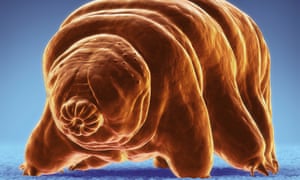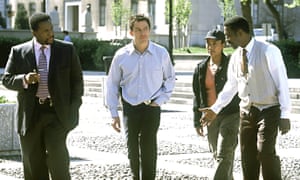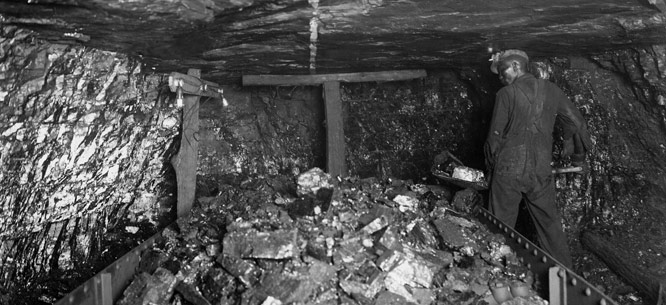via the Guardian by Nicola Davis
Microscopic creatures reassure scientists complete eradication of life on the planet is extremely unlikely

An illustration of a tardigrade. Photograph: Alamy
Whether it is a supernova or an asteroid impact, should a cosmic calamity strike, it seems there will be at least one form of life left: a tubby, microscopic animal with the appearance of a crumpled hoover bag.
The creatures, known as tardigrades, are staggeringly hardy animals, a millimetre or less in size, with species living in wet conditions that range from mountain tops to chilly ocean waters to moss and lichen on land.
“They can survive incredible conditions – we are talking close to absolute zero, the vacuum of space, exposure to radiation that would kill us, and these things just walk away from it like nothing happened,” said David Sloan, an astrophysicist from the University of Oxford.
Continue reading
I can accept evolution, it makes sense to me that some of the great apes evolved to form early humans but I not sure about direct descent from a tardigrade. Cuddly he may look but you'd have to find one that had magnifies by many thousands of times before you could hold it in your hand.
=============================
via OUP Blog by Susan R. Grayzel and Tammy M. Proctor

Arbeiten zur inneren Ausrüstung der Gasmasken, wie Einarbeiten des feinen Drahtgeflechts und Auskleiden der Innenwände mit Sand etc. by Unknown. Public domain via Wikimedia Commons.
Wonder Woman takes place in an alternative universe, yet the new film of the same name is set in a recognizable historical context: the First World War. For historians, this provides a chance to compare myth to reality. Putting aside the obvious and deliberate alterations – Erich von Ludendorff’s depiction in the story – the film touches on several of the themes that scholars still debate today regarding war and gender.
Diana Prince’s mission to defeat war shores up the myths that dominate the history of the First World War, both its claim to be in the words of sci-fi writer H.G. Wells, “the war to end all wars” and the most terrible and destructive war that the world had ever seen. Steve Trevor is portrayed as the honorable American doughboy with high-minded principles who is, of course, an aviator. The “Knights of the Air” continue to be a fascinating trope in popular narratives and films about the war, offering a new form of the military masculine ideal.
Continue reading
=============================
via Boing Boing by Mark Frauenfelder
=============================
via the Guardian by Peter Preston
Thanks to the likes of Netflix, the Disney channel and Nickelodeon, it is American media that is changing the UK’s culture, not Europe

Learning to speak American: Dominic West in hit US drama The Wire. Photograph: Everett Collection/Rex
A teenage granddaughter arrived for a summer stay. How was she? “I’m good,” she said. “What about you guys?” She didn’t go on to wish me an awesome day, but the message was still unmistakable. A child of the Disney channel and Nickelodeon, a social media devotee, she now belongs to the coming generation who, quite naturally and unthinkingly, speak American English.
Does that matter? Matthew Engel, one of journalism’s great exponents of English English, clearly thinks so. “As we approach 2020, the American words the British invited into their homes are in danger of taking over”, he writes in his new book, That’s the Way It Crumbles. “It has become possible to imagine a time – 2120 would seem a plausible and arithmetically neat guesstimate – when American English absorbs the British version completely. The child will have eaten its mother, but only because the mother insisted.”
Continue reading
=============================
via 3 Quarks Daily: Benjamin Dueholm in Aeon
'Gods change up in heaven, gods get replaced, prayers are here to stay.’ So wrote the late Israeli poet Yehuda Amichai. Anyone not sharing his conviction might consider a visit to the Blue Lotus Buddhist temple in Woodstock, Illinois. There, in a converted church, worshippers take their places between a massive new statue of the Buddha and the original stained-glass Christ, solicitous of his sheep. A series of actions takes place that could be focused on either image: a bell rings, the people stand, the clergy enter, and everyone bows in reverence. Then the work of prayer and meditation begins. The people chant their desire to take refuge in the Buddha and set themselves to focus on loving kindness.
Continue reading
=============================
via the Guardian by Michael Safi

A rare ‘pale tiger’ discovered in the wilds of Tamil Nadu state in India. Photograph: Nilanjan Ray
A rare “pale tiger”, whose fur conservationists say could be the fairest of any in the wild, has been photographed in southern India.
“It is the palest tiger I have ever seen on the record or heard about in literature,” said Belinda Wright, the founder of the Wildlife Protection Society of India.
The animal was spotted last week by wildlife photographer Nilanjan Ray while driving in Nilgiri biosphere reserve in Tamil Nadu state.
Continue reading
=============================
via the Library of Congress: Picture This by Julie Stoner

Battle of Peach Tree Creek, Georgia, July 20, 1864. Drawing by Adolph Metzner, 1864. hdl.loc.gov/loc.pnp/ppmsca.51237
As an admirer of Civil War drawings, a recently digitized collection of drawings by Adolph G. Metzner piqued my interest. The difference in style from many other drawings of the time, along with the richness of color, drew me in to learn more about this man and his artwork.
Continue reading
=============================
via the Guardian by Phyllis Richardson

Menabilly: Daphne du Maurier coveted the house for decades before she moved in and restored it
Howards End, Manderley, Brideshead – some fictional houses are as unforgettable as the characters who inhabit them. They can provide a sense of identity, as in the novels of Walter Scott, which were set in a time when a man was distinguished by the land and house from which he got his name. They can convey ideas of personality, as Charles Dickens’s living spaces reflect the quirks of his characters. They can offer us symbols of social status, as with Jane Austen’s Pemberley, or some tangible link to the past, as so ardently forged by writers such as Evelyn Waugh.
Continue reading
=============================
via 3 Quarks Daily: Michael Ralph in Dissent

Miner loading coal in Lynch, Kentucky in the 1920s. Lynch Photo Collection.
In the past decade, the coal-mining region that runs from Ohio to West Virginia has logged nearly 1,000 cases of “black lung disease” plaguing workers who’ve faced prolonged exposure to coal dust. But Senate Republicans have stalled legislation that retired coal miners desperately need to access the healthcare plans and pensions they were promised. Donald Trump became the forty-fifth president of the United States in part based on the claim that he would restore jobs by reviving the nation’s coal industry. But coal embodies capitalism’s most telling paradox: that the most lucrative industries are often the most dangerous. From the time it was first discovered in the United States in 1701 in Chesterfield County, Virginia, coal promised to revolutionize the world of energy and transportation. Yet, coal is responsible for untold damage to the environment and has led to the exploitation of workers – as laborers and assets – stretching back to the age of legalized slavery.
Continue reading
=============================
via Interesting Literature
The best Restoration comedies and tragedies
Restoration comedies and tragedies often get overlooked in our rush to celebrate the Elizabethan and Jacobean drama of Marlowe, Shakespeare, and Jonson. Yet any survey of English literature would be substantially poorer if it didn’t mention Aphra Behn, William Wycherley, or William Congreve. Below we introduce ten of the greatest works of Restoration theatre – comedies and tragedies, though mostly the former.
Continue reading
No comments:
Post a Comment